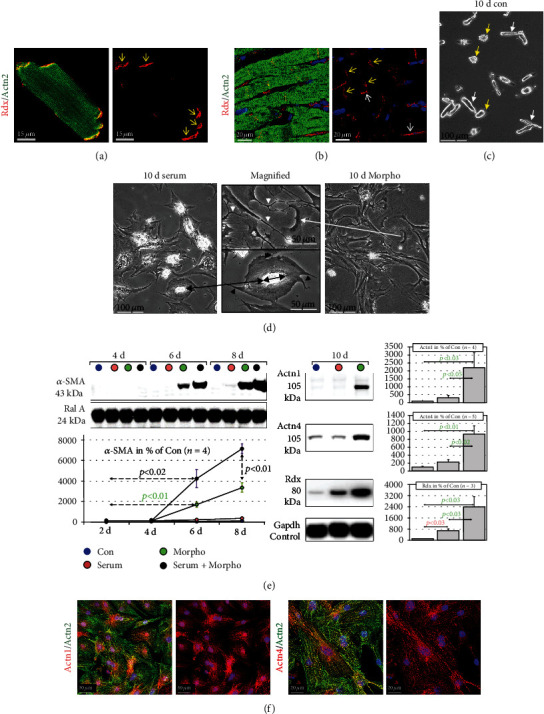Figure 2.

Serum and cardiac endothelial-derived morphogens induce distinct types of cardiomyocyte remodeling. Con are control cultures of adult rat cardiomyocytes treated with 0.2 mg/ml human serum albumin. Serum indicates serum stimulation, and Morpho specifies treatment with cardiac-derived morphogens (Morpho) from microvascular endothelial cells (see Methods) for the indicated time in days (d). Dedifferentiation markers are smooth muscle α-actin (α-SMA) and nonmuscle α-actinin-1 and α-actinin-4 (Actn1 and Actn4). (a) Freshly isolated adult cardiomyocytes show the typical rod-shaped phenotype in vitro. Radixin (Rdx, yellow arrows) staining defines the area of the intercalated disc. (b) The same applies to radixin staining of cardiomyocytes in the human myocardium (yellow arrows). Note that also some noncardiomyocytes in the interstitium are positive for radixin (white arrows). The Actn2 antibody stains sarcomeric α-actinin-2 in a cross-striated pattern. (c) A phase-contrast micrograph of the control group shows after 10 days that some cells still maintain a rod-shaped phenotype (white arrows) while other cardiomyocytes appear rounded (yellow arrows). (d) Phase-contrast micrographs show typical differences between the effects of serum and morphogens (Morpho) on cardiomyocytes after 10 days. The magnified image (long black arrow) shows a myocyte with an almost circular spread enlargement and little extensions after serum stimulation (black arrowheads). The double black arrow indicates the length and orientation of the original cell. In contrast, Morpho induces the formation of extremely long extensions with little lateral spreading (white long arrow and white arrowheads in the magnified image). (e) Western blot analysis reveals that Morpho induces dedifferentiation of adult cardiomyocytes. In contrast, serum stimulates very little α-SMA expression but enhances morphogen-induced dedifferentiation. Morphogens induce strongly the expression of Actn1 and Actn4. The expression of radixin (Rdx) reflects cardiomyocyte remodeling. Gapdh serves as a loading control. Statistical analysis is shown. (f) Confocal images show isolated neonatal cardiomyocytes (cell cultures from 3 d-old hearts).
